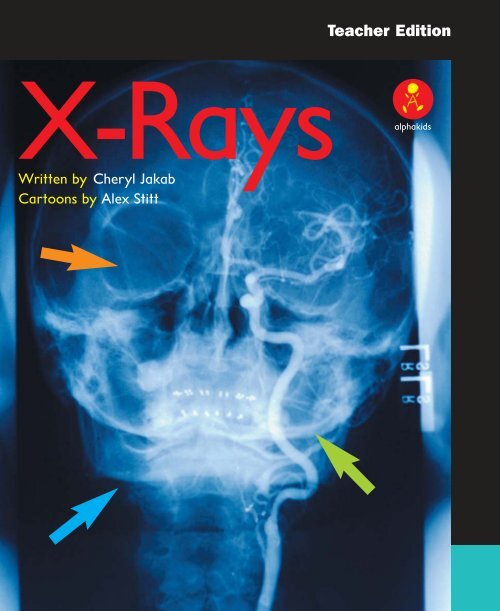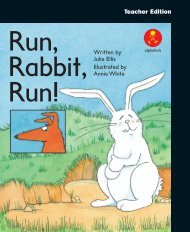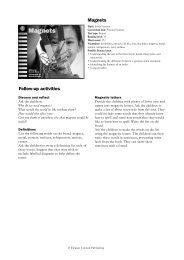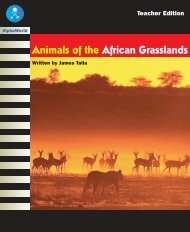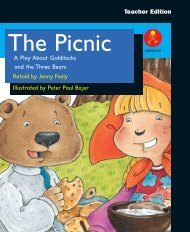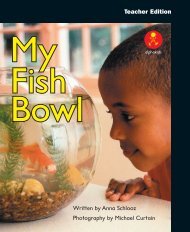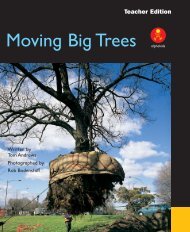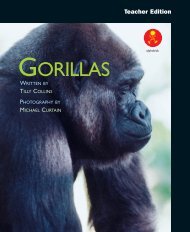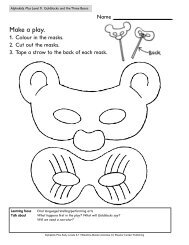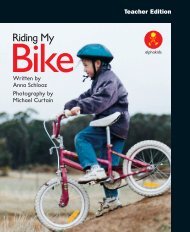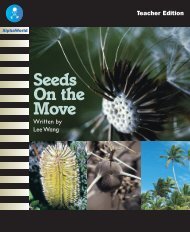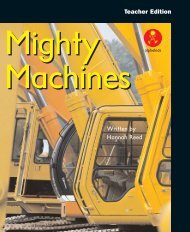TE X-Rays pages
TE X-Rays pages
TE X-Rays pages
- No tags were found...
Create successful ePaper yourself
Turn your PDF publications into a flip-book with our unique Google optimized e-Paper software.
Teacher EditionX-<strong>Rays</strong>Written by Cheryl JakabCartoons by Alex Stittalphakids
HORWITZ GARDNERLIMI<strong>TE</strong>D168e High StreetEgham, SurreyTW20 9HPUnited KingdomPublished edition© Eleanor CurtainPublishing 2004Text © Kerrie ShanahanPhotographs© Eleanor CurtainPublishingFirst published 2004Apart from any fair dealing forthe purposes of study, research,criticism or review, aspermitted under the CopyrightAct of Australia, no part of thisbook may be reproduced byany process, or transmitted inany form, without permissionof the copyright owner. Wherecopies of part or the whole ofthis book are made under PartVB of the Copyright Act, thelaw requires that records ofsuch copying be kept and thecopyright owner is entitled toclaim payment.Developed byEleanor Curtain PublishingDesigned byAlexander StittProduction byPublishing SolutionsPrinted in ChinaISBN 0 7253 3263 81 2 3 4 5 6 7 8 904 05 06How to use this bookThe Alphakids Plus teachereditions support teachers as theyguide children’s reading andthinking during one or more guidedreading sessions. Teachers canobserve children as they read andchoose from the given suggestionsto suit individual needs.Before readingSetting the context, front coverand title page:The suggestions help teachers toset the scene and prepare childrenfor reading the book. Prompts helpto determine children’s priorknowledge. Where necessary,background information isprovided. Teachers are encouragedto check that children understandthe vocabulary listed and to discussthe meanings and/or the structuresof these words. Previousexperiences with similar text typesmay also be discussed.During readingPredict, Read, Reflect:Questions encourage children toengage with the text by makingpredictions. They then read asection of the text and reflect onwhat they have read. The focus ison the content, language and textfeatures of the book.Observe and support:Prompts help teachers to focus onthe strategies children use as theyread. Teachers can then select fromand adapt the suggestions accordingto the needs of the individual child.The suggestions aim to develop achild’s reading abilities.Interruptions to the child’s readingshould be minimal.After readingA selection of reading and writingactivities:The last <strong>pages</strong> of the teacher editionprovide follow-up activities andinclude the assessment focus.Selected text features• X-ray pictures show what can be seenusing x-ray technology• Cartoons provide a humorous look atthe use of x-ray technology• Captions explain the x-ray picturesVocabularyaeroplane, airport, bones, broken,dangerous, dentist, doctor, hospital,machines, protective clothing, screen,vet, weaknesses, x-rays
Setting the contextIf possible, have an actual x-ray picture for the children to look at.What does this x-ray picture show?Discuss any interesting aspects of the x-ray picture, e.g. a broken bone, a visible ring.Have you ever had an x-ray taken? Why did you need an x-ray? How was the x-raytaken? What did the x-ray picture show?X-<strong>Rays</strong>Written by Cheryl JakabCartoons by Alex StittalphakidsX-<strong>Rays</strong>Written by Cheryl JakabCartoons by Alex StittalphakidsFront coverWhat does this picture show?What is this type of picture called?Title pageRead the title, the author’s name and thename of the cartoonist.What are cartoons? Did you expect tosee cartoons in this book? Why?
X-<strong>Rays</strong> Pages 2–5PredictLook at <strong>pages</strong> 2 and 3. What does this x-ray pictureshow? What does the cartoon show us?Look at <strong>pages</strong> 4 and 5. What can you see in thisx-ray picture? What do you think the man is doing?Read to the end of page 5.ReflectWhy can you see the ring on the person’s finger inthis x-ray picture?What other things show up on an x-ray picture?How does the cartoon help you to understand theinformation?Observe and supportCan the child interpret the text at theliteral level?Why do people use x-rays?What things show up in an x-ray picture?How do x-ray pictures help doctors?2
IntroductionPeople use x-rays to see inside things.X-rays show us things that we cannotusually see.X-rays can pass through soft things like skin.They cannot pass through hard thingslike bone and metal.Hard things show up on the x-ray picture.2 3X-rays at the hospitalDoctors use x-rays to see inside your body.The x-ray pictures tell the doctor if any ofyour bones are broken.The x-ray pictures help the doctor work outhow to help you to get better.X-rays cannot pass throughthe bones in your body.The bones show up on thex-ray picture.The x-ray picture showsa broken arm.4 53
X-<strong>Rays</strong> Pages 6–7PredictWhat do you think is happening in this picture?Why might you need an x-ray of your mouth?What would an x-ray picture like this show the dentist?Read <strong>pages</strong> 6 and 7.ReflectWhat shows up in an x-ray picture of your mouth?Have you ever had an x-ray at the dentist?What things on this page help you to understand theinformation?Observe and supportCan the child integrate information on the page tosolve problems?At the point of need you might say:What can you see in the picture?What would make sense here?Look at the letters in the word. What sounds do theyrepresent? What sort of word do we need here?4
X-rays at the dentistDentists use x-rays to see if thereare any problems with teeth andgums.The hard parts of the mouth, liketeeth and bones, show up on thex-ray picture.If you have a hole in one ofyour teeth, the x-ray pictureswill show the dentist where it is.Then she can fix it.The x-ray picture shows ametal filling.The x-ray picture showssome tooth decay.6 75
X-<strong>Rays</strong> Pages 8–11PredictLook at the information on <strong>pages</strong> 8 and 9. What dothese x-ray pictures show?What other animals might have x-rays taken?Look at <strong>pages</strong> 10 and 11. Where might you see thissort of x-ray? What does it show?Read to the end of page 11.ReflectDid you know that animals could have x-rays taken?Why would you need an x-ray machine like this at anairport?What sort of things would show up on an x-ray picturefrom this machine?Observe and supportCan the child read factual texts clearly so that theinformation is easy to understand?Well done, I could hear each word clearly whichhelped me to understand the information.Does the child pay attention to punctuation to assistwith fluent reading?I noticed that you paused when you saw a comma.This helped me to hear each word clearly.6
X-rays at the vetThe vet uses x-rays to check that theanimals do not have any broken bones.If an animal has a broken bone, the vet willmend the bone using pins, splints orbandages.The x-ray picture shows that the dog has a broken bone.The x-ray picture shows a steel pinused to mend the dog’s broken bone.8 9X-rays at the airportX-rays are used at the airport to see insidesuitcases and bags. Things that should not goon the aeroplane, like guns, knives and spray cans,will show up on the x-ray picture.10 What can you see inside this bag?117
X-<strong>Rays</strong> Pages 12–13PredictWhat does this diagram tell us? What helps us tounderstand the diagram?Why might these x-ray pictures be useful?Read page 12.ReflectDid you know that x-rays are used to take pictures likethese?How do these x-ray pictures help people?What helped you to understand what these x-rays areused for?8Observe and supportCan the child use a range of strategies to decode newvocabulary such as ‘aeroplanes’?You might say: What sort of word needs to go here?Is it the name of something?Look at the diagram. Does this give you a clue?Cover the letters ‘aero’ with your finger.What letters can you see in the rest of this word?What sound do they make?What does this part of the word say? Would thatword make sense?
X-rays and machinesX-rays are used to check that machines likecars, trucks and aeroplanes are strong andsafe.Any cracks or weaknesses in the machineswill show up on the x-ray picture. If part ofa machine is cracked or damaged, it can berepaired or replaced.12139
X-<strong>Rays</strong> Pages 14–16PredictHow many x-rays have you had?Is it safe to have a lot of x-rays?What information might you learn from these <strong>pages</strong>?Read to the end of page 16.ReflectWhat sort of things can people do to protect themselvesfrom x-rays?How do x-rays help people?What new information have you learned about x-rays?10Observe and supportCan the child use their knowledge of phonics tosupport their reading?If the child is having difficulty you might promptthem by saying:Look at the beginning of the word. What sound dothese letters make? Do you know a word that beginslike this?Check the end of the word.What sound should you hear? What would makesense here?
X-ray safetyX-rays can be dangerous.People or animals who are near strong x-raysfor a long time will get ill, so anyone whouses x-rays must be very careful.They must wear protective clothing or standbehind a screen.DANGERX-Ray RoomDo not enterwhen red lightis flashing14 15ConclusionX-rays can be very useful.They are used to help people and animalsget the treatment they need.They are used to help people build safermachines.They are used to keep dangerous things outof aeroplanes.1611
After readingBeing a meaning makerEncourage the children to supporttheir answers with evidence fromthe book as they discuss thesequestions:What is an x-ray?Why do people use x-rays?Why are x-rays used at the airport?Should you have lots of x-rays?Why?How are x-rays useful?Being a code breakerChildren may like to explore thefollowing language features:• sounds associated with the use ofthe letter ‘x’ throughout the book:x-ray, fix• the sound /o/: bones, broken, go,show, bone, so, protective clothingBeing a text userPoint out the captions, labels andpointers used in the text.What are these called?What do they tell us?When do we read them?Why do we read them?Being a text criticWhat research would this authorhave done before writing this book?What other things could she haveincluded in the book?12
Responding to textChildren could work incooperative groups to makean audiotape of interviews with arange of people who use x-rays.Encourage the use of questions toprompt interviewee responses.Children could writesentences to explain some ofthe x-ray photos shown in the book.Encourage the use of illustrations,diagrams, labels and captions tosupport their writing.Children could look throughthis book and other familiarbooks to list a range of words thatcontain the letter ‘x’. These couldbe grouped according to the soundthe letter represents, e.g. box,xylophone.Writing linksShared writingHave children work together insmall groups to organise theinformation they have learnt fromthe text. They could use the text tohelp fill in a chart with thefollowing headings:Where isthe x-raytaken?Why isthe x-raytaken?Whatdoes thex-raypictureshow?Drawingof the x-raypictureIndependent writingChildren could write about a timewhen they, or someone they know,may have experienced the use ofx-rays. Encourage children toillustrate their writing with comicillustrations.Possible assessment focusCan the child:• explain what is happening in the photos?• explain what information the photos provide?• explain why the illustrator has used comic illustrations?whole text activity sentence activity word activity
alphakidsalphakidsalphakidsalphakidsalphakidsX-<strong>Rays</strong>Written by Cheryl JakabCartoons by Alex StittTeacherEditionOtherbooksat thislevelVeronica Who Lived in aVinegar BottleWritten by Sue WhitingIllustrated by Steve AxelsenTopic: X-raysCurriculum link: TechnologyText type: ExplanationReading level: 18Word count: 335Vocabulary: aeroplane, airport, bones, broken,dangerous, dentist, doctor, hospital, machines,protective clothing, screen, vet, weaknesses, x-raysTheCheerfulCricketA playRetold byJulie EllisIllustrated byMarjory GardnerWritten by Jenny FeelyPhotography by Michael CurtainalphakidsCity and CountryPossible literacy focusUsing text to understand photos.Exploring the use of photographs in non-fictiontexts.Reading and understanding the use of comicillustrations in non-fiction texts.Farmyard FriendsWritten by Sara Oldfield Photography by Ross TonkinBirdFamiliesWritten by Marilyn WoolleySummaryThis book explains the many uses of x-rays.ISBN 0- 7253- 3263- 89 780725 332631alphakids


